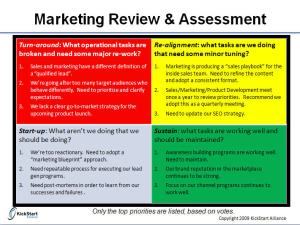Example of a tactical “Marketing Blueprint” for events January 20, 2015
Posted by Mike Gospe in blueprints, Integrated Marketing, Marketing Operations, programs.Tags: blueprints, event blueprint, events, Integrated Marketing, Lead Generation, marketing blueprints, Marketing Campaigns, Marketing Operations
add a comment
What is a “marketing blueprint”? This continues to be a good question and a source of confusion amongst marketers because blueprints are often confused with Excel spreadsheets of Microsoft Project. Here are 4 things to know about blueprints and a tactical example to shed some light. (more…)
Welcome to 2012 CAB season – have you started planning your customer advisory board? January 23, 2012
Posted by Mike Gospe in Customer Advisory Boards.Tags: CAB, CABs, Customer Advisory Board, Customer Advisory Boards, Customer Council, Marketing Operations
add a comment
Sunshine is breaking through the recessionary clouds of the past few years. Signs of cautious optimism are sprouting everywhere, giving hope that 2012 will be a pivotal year that will show continued improvement in the global economy. Many companies report a stronger-than-expected Q4, the DOW is moving forward, and most business people I know have greeted the new year with a smile. This is why now is the perfect time to planning your Spring Customer Advisory Board meeting. (more…)
More on marketing best practices September 29, 2011
Posted by Mike Gospe in Leadership.Tags: Leadership, marketing best practices, Marketing Operations
add a comment
With the launch of The Marketing High Ground, I was interviewed by the editors of DemandGen Report. Our discussion covered a variety of topics. I’ve captured excerpts of the interview based on specific topics of interest and thought I would pass them along. (more…)
The role of the campaign manager: 5 key traits September 6, 2011
Posted by Mike Gospe in Just for Campaign Managers.Tags: Integrated Marketing, Marketing Operations
add a comment
A client recently asked me for some advice about hiring a seasoned “campaign manager.” Whether your organization has a formal role designed to manage integrated marketing campaigns, or you are a solo product manager trying to guide the organization, or you sit somewhere in between, these 5 traits are worthy of your aspiration. (more…)
The role of the product launch boss in the NPI process August 23, 2010
Posted by Mike Gospe in Integrated Marketing, Just for Campaign Managers, Marketing Operations.Tags: launch boss, marketing best practices, Marketing Operations, new product introduction, NPI
add a comment
What is the role of the launch boss in the new product introduction (NPI) process?
This is a good question. One that can lead to confusion and consternation if the role isn’t clearly defined at the outset. I had the opportunity to attend a conference hosted by the Product Realization Group last week. Often, but not always, this role falls on the shoulders of someone in product management or product marketing. Rob Bisaillon, director of new product introduction at Verigy Memory and Application Specific Test Systems Division, offered a few success factors regarding the NPI process, and insights into the most effective product launch bosses.
Rob’s list of Key Success Factors included:
- Team formation & kick-off: define the team, name all active team members and communicate their involvement to the rest of the organization beginning with a kick-off meeting to align participants and set expectations.
- Set clear goals and deliverables: time tables often change, so adopt a discipline of setting and communicating goals often. Whether deliverables are engineering-, production-, or marketing/sales-related, make a point to include a short one-line description of each regarding the who/what/when/where/why associated with any/all deliverables. This helps to avoid any confusion down the road.
- Action tracking and reviews: be formal about tracking the status of open action items. Many teams use the red-yellow-green color scheme to highlight status. Microsoft Project(TM) is an example of a good tool to use.
- Timely resolution of issues: when open issues are not resolved quickly, they fester. A good launch boss will grab the bull by the horns to wrestle the issue to resolution. Effective launch bosses are always diplomatic, but they are not afraid to to tackle sticky issues and bring them before a steering committee for a final resolution.
- Check point reviews with executive management: the effective NPI team will have structured review meetings with upper management. These meetings are sometimes referred to as “Gate” meetings. When differences in opinions arise (and they will), the NPI leader’s role is not to dictate the final answer. Instead, the effective product launch boss will bring the issue, with a recommendation, to the steering committee for them to vote on or resolve.
- Executive sponsorship: a bottoms-up approach to product launches only works so far. Without executive sponsorship to guide and direct decisions and team behavior, the NPI will suffer and frustration levels will rise.
With these six key points in mind, Rob went further to offer that while product experience is important, the most important characteristics of an effective launch boss are their temperament, attitude, and ability to clearly communicate with team members. In fact, product knowledge and technical expertise are usually in great supply; whereas, the ability to navigate politics, soothe feathers, and guide a cross-functional team to success is not quite as common.
Adding my own thoughts to Rob’s, I believe the single hardest thing for a launch boss (or integrated campaign manager!) to do is to get team members to take action when, in fact, they don’t report to you. When the launch boss resorts to dictatorial action, the risk of failure increases. But, when team leaders leave their egos at the door, invite cross-functional participation and leadership, and focuses on managing the process not the outcome, teammates will recognize and favor the launch boss’ value-add.
If you have an example of an exceptional launch boss, or a poor one, I’d love to hear your story.
Aligning Sales & Marketing With the Lead Flow Process July 19, 2010
Posted by Mike Gospe in Integrated Marketing, Lead Gen, Marketing Operations.Tags: Integrated Marketing, Lead Generation, Marketing Operations
add a comment
Ever been in the middle of the following heated dialog between the VPs of sales and marketing?
“Marketing sends us lousy leads!”
“The leads are fine! The problem is that Sales can’t close!”
These statements are symptomatic of one or more areas of dysfunction between sales and marketing. The three most common alignment problems are ambiguity, finger pointing and ignoring reality. Janet Gregory, a veteran sales leader, wrote a wonderful article on how to identify the warning signs and what can be done to foster tighter alignment.
How have you been successful in aligning marketing and sales? I invite you to share your stories.
Characteristics of Effective Campaign Managers September 21, 2009
Posted by Mike Gospe in Integrated Marketing, Just for Campaign Managers, Marketing Operations.Tags: brand managers, campaign managers, Integrated Marketing, integrated marketing team, marcom mix, marketing best practices, marketing blueprints, Marketing Campaigns, Marketing Operations, marketing programs
add a comment
“I’m looking to hire a campaign manager to oversee our integrated marketing programs. What are the characteristics of the best campaign managers?”
I get asked this question a lot. Earlier in my career, I worked as a campaign manager at HP, Sun, and Ariba , so I’ve seen the good, bad, and the ugly. I’ll be up front with you and say that I’ve made my share of mistakes along the way. That experience opened my eyes to the marraige of marketing expertise with an appreciation for internal politics.
The biggest challenge campaign managers have is that they have a purview over an integrated marketing campaign (aka the “big picture”) but no direct authority over the team players who will execute the campaign. They walk a tightrope between meeting the campaign goals while aligning and carefully guiding a team of folks who have other masters. With that in mind, the most effective campaign managers have these traits in common:
- A recognized, well-rounded marketing leader familiar with the target market
- Proven leadership experience in “managing by objective” Attentive to detail, but smart enough not to micro-manage
- Diplomatic and politically savvy
- Patient
- A good facilitator, seasoned in active listening techniques
- Excellent written and oral communicator (with the team, to upper management, and in front of the steering committee)
- Knows when and how to provide constructive feedback in real time during team meetings; knows when and how to provide direct feedback in one-on-one settings
- Is prepared to make hard decisions and trade-offs for the greater good of the campaign
- Most of all, doesn’t let their ego get in the way of sound recommendations
There’s art and science in this role. The science comes from understanding sound marketing best practices. More important than understanding the specific products being sold, the best campaign managers bring an awareness and appreciation for the customer and their business problems and opportunities. While they usually won’t know all the answers, their expertise comes in knowing the right questions to ask the team in order to define, architect, and execute the best, most effective integrated marketing campaigns. That’s the art.
Looking for more information on integrated marketing campaigns? Please see Chapter 7 in Marketing Campaign Development.
How well is your marketing team performing? July 7, 2009
Posted by Mike Gospe in Integrated Marketing, Marketing Operations.Tags: 360 degree audit, Integrated Marketing, Lead Generation, marcom mix, marketing audit, marketing best practices, marketing blueprints, Marketing Campaigns, Marketing Operations, practical application workshops
add a comment
As businesses gear up for the fall quarter, it is timely to take a few moments to revisit past marketing communications programs and evaluate their success. But, the last thing you want in an audit is a “marketing free-for-all blame game.” Instead, use this simple 2×2 matrix to help you capture and align the issues.
 Depending on your need, you may want to hire an outside expert to work with you to perform an unbiased audit. Or, you might be interested in holding your own half-day team offsite. Either way, here is a structure that I have found works great to capture, categorize, and then prioritize actions.
Depending on your need, you may want to hire an outside expert to work with you to perform an unbiased audit. Or, you might be interested in holding your own half-day team offsite. Either way, here is a structure that I have found works great to capture, categorize, and then prioritize actions.
An effective 360 degree audit will look at the following:
- Plans: The current plans and programs (with scrutiny and focus on the marketing objectives and program blueprints).
- Processes: The internal processes for capturing and distributing leads (with a review of any CRM and marketing automation tools you are using).
- People: A review of the marketing skills your team possesses and those they lack, as well as what skills you are outsourcing.
As you review these 3 dimensions, categorize your findings in one of 4 groupings:
- Turn-around
- Re-alignment
- Start-up
- Sustain
An example audit is shown in the attached graphic. During a half-day offsite, the marketing leadership team performed a frank assessment and prioritized the insights which are captured in the graphic. Action items were then identified and assigned to owners. The team will be reconvening next month to update each other on the progress and confirm the metrics and measurement for a successfull Q3 and Q4.
Consider performing your own 360 degree audit and let me know how this technique works for you. For questions or tips on how to structure the most effective “working session” offsite, feel free to email me at mikeg@kickstartall.com or post your comments on this blog.

